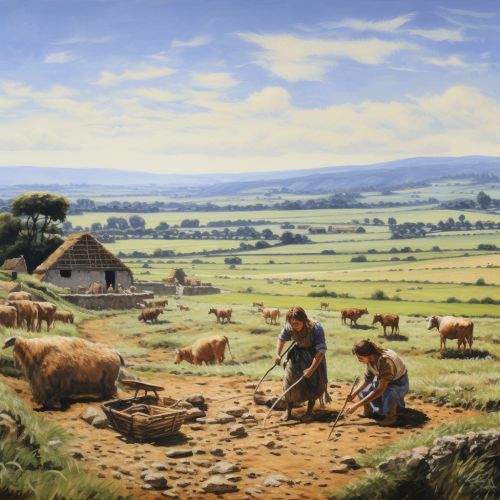Neolithic period
Introduction
The Neolithic period, also known as the New Stone Age, was a significant era in human history marked by the transition from nomadic hunting and gathering communities to agriculture and settlement. This period, which occurred between 10,000 B.C. and 2000 B.C., brought about profound changes in human society and culture, including the development of farming, domestication of animals, and the creation of permanent settlements.
Origins and Development
The Neolithic period began with the advent of farming, which in turn led to the Neolithic Revolution. This revolution was characterized by the transition from small, nomadic bands of hunter-gatherers to larger, agricultural settlements and early civilization. The Neolithic Revolution is considered the first agricultural revolution, denoting the transition in human history from small, nomadic bands of hunter-gatherers to larger, agricultural settlements and early civilization.
Agriculture
The development of agriculture was a cornerstone of the Neolithic period. Early humans began to cultivate crops and domesticate animals, leading to a shift from a lifestyle of hunting and gathering to one of agriculture and settlement. This shift allowed humans to produce their own food without having to relocate. Agriculture led to the rise of the first sedentary societies, as well as the advent of the human civilization. These societies were able to create villages and even cities. From these communities emerged new forms of complexity like social hierarchy, specialized craft production, and monumental architecture.


Domestication of Animals
Alongside the cultivation of plants, the domestication of animals was a key aspect of the Neolithic period. This process, which involved the taming and breeding of animals for human use, was a crucial development in human history. Domesticated animals provided a reliable source of meat, milk, and hides. They also served as work animals, pulling plows and carts, and were used for transportation.
Settlements and Architecture
The establishment of permanent settlements was another defining feature of the Neolithic period. With the advent of agriculture, humans were able to remain in one place for longer periods of time, leading to the development of permanent settlements. These settlements, often located near water sources, were typically made up of mud-brick houses. As these settlements grew, they evolved into complex societies with distinct social structures and roles.
In terms of architecture, the Neolithic period saw the construction of megalithic structures. One of the most famous of these is Stonehenge in England. These structures required a significant amount of human labor and resources to construct, indicating a level of social organization and complexity not seen in earlier cultures.
Societal Changes
The societal changes that occurred during the Neolithic period were significant. The shift from nomadic life to settled farming led to the development of social hierarchies, trade, and craft specialization. The surplus of food allowed some people to engage in activities other than food production for the first time. This led to the development of new professions, such as craftsmen, traders, and religious leaders.
End of the Neolithic
The end of the Neolithic period came with the advent of the Bronze Age, when the development of metal tools began to displace stone tools. This was a gradual change, rather than a sudden one, and different parts of the world entered the Bronze Age at different times.
